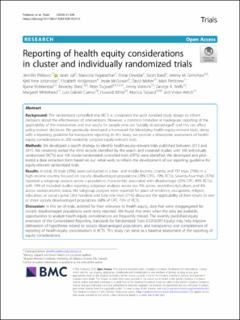| dc.description.abstract | Background
The randomized controlled trial (RCT) is considered the gold standard study design to inform decisions about the effectiveness of interventions. However, a common limitation is inadequate reporting of the applicability of the intervention and trial results for people who are “socially disadvantaged” and this can affect policy-makers’ decisions. We previously developed a framework for identifying health-equity-relevant trials, along with a reporting guideline for transparent reporting. In this study, we provide a descriptive assessment of health-equity considerations in 200 randomly sampled equity-relevant trials.
Methods
We developed a search strategy to identify health-equity-relevant trials published between 2013 and 2015. We randomly sorted the 4316 records identified by the search and screened studies until 100 individually randomized (RCTs) and 100 cluster randomized controlled trials (CRTs) were identified. We developed and pilot-tested a data extraction form based on our initial work, to inform the development of our reporting guideline for equity-relevant randomized trials.
Results
In total, 39 trials (20%) were conducted in a low- and middle-income country and 157 trials (79%) in a high-income country focused on socially disadvantaged populations (78% CRTs, 79% RCTs). Seventy-four trials (37%) reported a subgroup analysis across a population characteristic associated with disadvantage (25% CRT, 49% RCTs), with 19% of included studies reporting subgroup analyses across sex, 9% across race/ethnicity/culture, and 4% across socioeconomic status. No subgroup analyses were reported for place of residence, occupation, religion, education, or social capital. One hundred and forty-one trials (71%) discussed the applicability of their results to one or more socially disadvantaged populations (68% of CRT, 73% of RCT).
Discussion
In this set of trials, selected for their relevance to health equity, data that were disaggregated for socially disadvantaged populations were rarely reported. We found that even when the data are available, opportunities to analyze health-equity considerations are frequently missed. The recently published equity extension of the Consolidated Reporting Standards for Randomized Trials (CONSORT-Equity) may help improve delineation of hypotheses related to socially disadvantaged populations, and transparency and completeness of reporting of health-equity considerations in RCTs. This study can serve as a baseline assessment of the reporting of equity considerations. | en_US |

